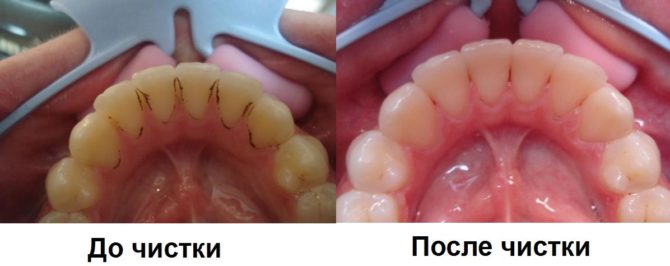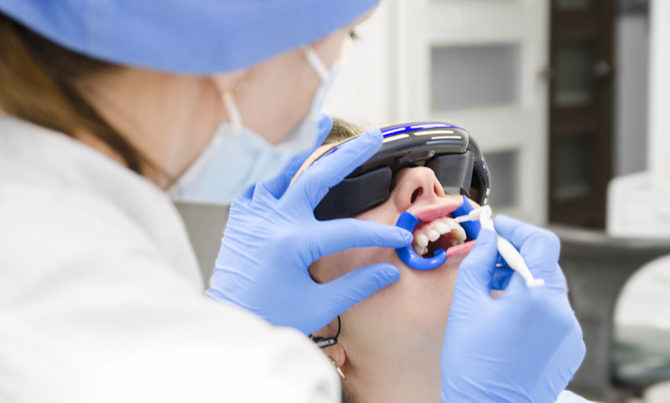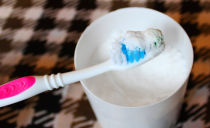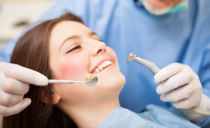Ultrasonic cleaning of teeth from tartar
It is known that you need to brush your teeth at least 2 times a day and use floss, monitor your diet and regularly visit the dentist. Ideally, all these measures should ensure the health of our smile, but sometimes they are not enough. Experts note that even with all the rules of oral hygiene, petrified dental deposits occur. The most effective method of removing them is to clean the teeth from tartar with ultrasound.
Content
What is ultrasonic brushing?
No matter how diligently you take care of your teeth, sooner or later you will have to face tartar. It is a long-standing deposits on the surface of enamel, which are composed of food debris, dead cells and minerals. First of all the stone is formed between the teeth and under the gums - where deposits are most difficult to remove with a regular brush. But they are easy to remove with ultrasound brushing.
Plaque develops much faster if there are additional factors:
- Using a low-quality brush or paste.
- The prevalence of soft foods in the diet.
- Chewing food with only one side of the jaw.
- Violation of the salt metabolism of the body.
- Incorrect or irregular brushing.
- Congenital predisposition in the form of a rougher enamel surface.
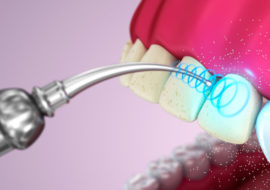 There is no doubt which toothbrushing from stone is better, because the ultrasonic method has long replaced the rest. It is carried out using a special apparatus called an ultrasonic scaler. The device delivers a directed flow of water to the enamel surface, and a special nozzle creates vibrations in the ultrasonic range. In just a minute, she makes about 100 thousand movements in different directions, thanks to which she carefully removes plaque even in the most inaccessible areas.
There is no doubt which toothbrushing from stone is better, because the ultrasonic method has long replaced the rest. It is carried out using a special apparatus called an ultrasonic scaler. The device delivers a directed flow of water to the enamel surface, and a special nozzle creates vibrations in the ultrasonic range. In just a minute, she makes about 100 thousand movements in different directions, thanks to which she carefully removes plaque even in the most inaccessible areas.
Ultrasonic cleaning of tartar and plaque gave rise to other areas and research in aesthetic dentistry. Largely thanks to her, Air Flow gentle whitening of teeth has appeared and has become popular, which in its action resembles the removal of plaque by ultrasound.
The benefits of ultrasonic toothbrushing from stone
Ultrasonic cleaning appeared in dentistry as a replacement for more dangerous methods of calculus removal. Previously, mechanical cleaning was used everywhere, during which deposits were scraped from the teeth with a special tool. It is easy to imagine how harmful and dangerous this procedure is. Damage to the enamel was noticeable.
Ultrasound in dentistry has been used recently, but nevertheless, cleaning has already replaced older methods, because it has a large number of advantages:
- The scaler and its nozzle do not touch the enamel, but act at a distance, which eliminates mechanical damage.
- Cleaning not only removes plaque, but also makes the teeth whiter.
- The effect of the procedure is long-term: repeat cleaning no more than 1-2 times a year.
- It is possible to remove plaque even in the most inaccessible areas.
- During the cleaning process, oxygen is released, and it has an antiseptic effect.
- The procedure lasts no more than one hour.
- Ultrasound brushing has contraindications, but not as many as mechanical removal of petrified plaque.
- After the procedure, there is no recovery period during which another dental intervention is prohibited.
Disadvantages of Ultrasonic Toothbrushing
The list of benefits turned out to be impressive, but still this procedure is not ideal. The method has its drawbacks:
- Despite the general painlessness, many patients report discomfort due to the strong pressure of water.
- The cost of the procedure is not the most affordable.
- If cleaning is improperly performed, gums can be seriously harmed.
- Do not repeat cleaning more than once every 6 months, otherwise the sensitivity of soft tissues will increase.
In defense of professional ultrasonic brushing, it is worth adding that many of the shortcomings relate not only to this procedure, but also to many other services of aesthetic dentistry. All of them should be performed only by specialists and should not be abused. Judging by the reviews on various resources, the only serious drawback of ultrasonic cleaning is its high price.
How to carry out the ultrasonic cleaning procedure
Few people fully understand what ultrasonic brushing is and how it happens. Usually, when you first go to the dentist, it is not performed. First, the dentist will make a full examination of the oral cavity and conduct a survey during which it may turn out that the procedure is completely contraindicated for you.
If everything is in order, cleaning can be done on the first day of treatment. First, if the patient wishes, an anesthetic injection is made in the gum area. In most cases, this is not necessary, because the procedure is not very painful. Anesthesia is required only for people with hypersensitivity or special indications for it.
Then the preparation begins. The patient is given safety glasses. A latch is inserted into the mouth, which for a long time holds it in the open position. Then put a tube of "saliva ejector", which will also remove excess water.
Further, the specialist sets up the device for cleaning the teeth with a scaler. Depending on the amount of plaque, different power and speed of the main nozzle can be selected.
The teeth are alternately treated with a scaler, each given at least one minute. The spaces between the teeth are given more time, sometimes strips and cavities coated with abrasive material are used to clean them.
When all the teeth are cleaned with a scaler, the procedure can be considered complete, but in a good clinic, enamel polishing and fluorination are additionally done, which are already included in the full price of the service. All this allows you to repeat professional cleaning less frequently.
Contraindications to ultrasonic brushing
As with any other dental procedure, ultrasonic cleaning has its own contraindications:
- All diseases of the internal organs, especially the cardiovascular system.
- Chronic diseases in the acute stage.
- Inflammation and damage to teeth or gums.
- Hypersensitivity of enamel and mucous membrane.
- The presence of removable or non-removable prostheses, since ultrasound brushing can damage them.
- Serious infectious or viral diseases.
- Respiratory diseases like asthma or bronchitis.
- Return of the patient to 18 years.
- Pregnancy and the first six months of breastfeeding.
Some of these contraindications, for example, exacerbations of diseases, are not considered absolute. Simply transfer the procedure to a more appropriate time when you will feel better.
Is ultrasonic brushing harmful, how often can I do
Even toothbrushing with ultrasound can be harmful if abused. To clean the enamel is at least 1 time per year. The interval between the procedures at 6 months is just perfect, more often it is not worth doing it.
Too frequent ultrasound cleaning leads to hypersensitivity and inflammation of the gums.Another repeated procedure causes more discomfort if the correct interval between visits to the dentist has not been observed.
To prolong the effect of ultrasound and resort to it less often, it is worth adding more solid food, fresh fruits and vegetables to your diet, brushing your teeth after each meal, using not only a brush and paste, but also a floss, and a rinse aid. Even better if all of these methods are part of your daily oral care.
Polishing and fluoridation of enamel will also allow you to return less often to the dentist's office for profile cleansing of enamel. Polishing should be done every time, and fluoridation is sometimes better to skip.
How much does ultrasonic brushing cost
The main disadvantage of toothbrushing with ultrasound is the price. Usually it is calculated depending on the number of teeth requiring cleaning. If we are talking about a preventive procedure, then its cost is already fixed: in Moscow and St. Petersburg, the service costs at least 4–5 thousand rubles, in smaller cities it costs much less, but it’s more difficult to find a suitable clinic in them.
If you care about the condition of the teeth, you need to include such a service among your regular dental procedures. You can do ultrasonic toothbrushing not very often: only once a year - but this will be enough to further protect yourself from a number of problems with a smile and expenses for their treatment.


